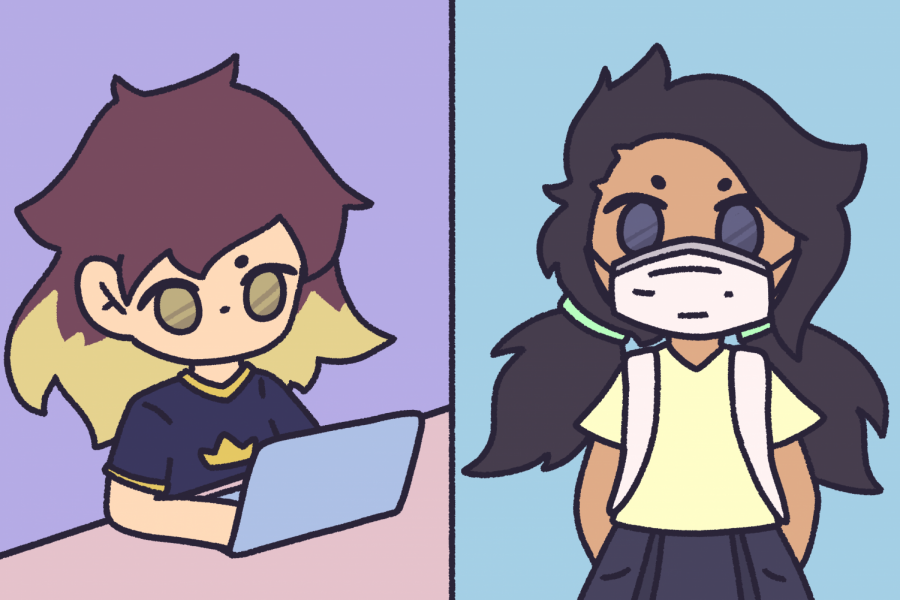Maryland school districts create return-to-school plans
RM has fully completed the school reopening process and continues to regulate a hybrid instruction model.
February 9, 2021
With the coronavirus pandemic having quickly made an impact on services and businesses last March, schools around the country had to act swiftly to determine what would happen to their students.
For Montgomery County Public Schools, they gave students a two-week period between their infamous last day of in-person learning, March 13, and the beginning of virtual learning. During that time, administrators and head MCPS officials worked together to create a plan for schools and students.
MCPS’ changed their traditional letter grade system to an optional pass/fail system in the fourth quarter of the 2019-2020 school year. They allowed students to have the choice of receiving one letter grade higher than they did in the third quarter, or having a grade of “pass” if they had a grade of D or higher. MCPS also instituted a fully asynchronous schedule, allowing students to only go to class if they felt they needed to receive help.
For sophomore Nathaniel Foster, he would describe distance learning last school year as unprepared. “Everything felt rushed and incoherent, and it was a very different experience in each of my classes. Some [teachers] were very strict about the amount of work they wanted us to do while others just gave us some assignments and left us be,” he said.
However, this was not the opinion of all students. For sophomore Raya Arora, she thought that MCPS did a good job of creating a plan for students. “It was very self-led, but not to the point where I was stressed all the time,” she said.
Although Foster and Arora have different views on the distance learning approach that MCPS took last spring, both believe that the school district’s current virtual learning plan is not functioning well for students.
“Virtual learning this year is extremely stressful, spending 4 hours on my computer in class, plus 2-6 hours for homework almost every day. This can’t be safe for students’ vision,” Arora said.
Foster’s opinion on the matter corroborated with Arora’s. “I think MCPS has improved organizationally since the spring, but there are still plenty of unsolved issues. In-person, we would listen to the teacher instruct and then do the classwork. On Zoom, however, we mostly just listen to the teacher and then do classwork and additional homework later. We spend hours on Zoom only to get more homework,” Foster stated.
As these feelings seem to trend amongst most students, MCPS head officials are working to return students back to schools and begin a hybrid learning model. To help with their decision, MCPS gave parents a survey asking if they would rather have their student remain virtual or follow the hybrid model.
With about 127,000 responses received, the results were almost exactly split. 50.2 percent of parents preferred that their student remains virtual, while 49.8 percent opted for the hybrid model.
Currently, families that selected the hybrid model are set to return March 15, but only if metrics are met and it is deemed safe to return to school. One of these metrics includes a less than 5 percent test positivity rate in the state.
Nonetheless, MCPS has given strict measures that would have students remain fully virtual for the second semester. For example, if the 14-day raw average of new cases is greater than 157, students will continue to be virtual.
With high school students, MCPS currently has seniors returning to school in its second group of students for Phase 1. Freshman and juniors would go back first in Phase 2, and sophomores would be the last grade to enter.
As of Dec. 1, nearby Prince George’s County Public Schools has decided to stay virtual until further notice due to COVID-19 surges around that time. For a return to in-school learning, the percentage of positive cases per day (between 5 and 8 percent) and the number of new cases (between 46 and 91) will be determining factors.
“I am hopeful that we will be able to welcome our students and teachers back to in-person learning once it is safe. As we monitor COVID-19, we will continue distance learning until further notice,” Monica Goldson, the current Chief Executive Officer of Prince George’s County Public Schools, said in a letter to the community.
Foster prefers Prince George’s plan as opposed to MCPS’. “The way the COVID-19 pandemic has gone so far, I think it would be best for MCPS to stay in a virtual learning environment,” he said.
For science teacher Helen Ghent-Paolucci, “Mostly, it comes down to what the local health officials are recommending” about whether or not students and staff return in-person. “I prefer face to face in-class learning, especially since the classes I teach are lab-based. So it’s pretty difficult to create labs virtually,” she said.
Other Maryland school districts such as Howard County Public Schools and Baltimore City Public Schools have chosen to begin bringing small in-person groups back into every school starting next month if benchmarks are met, while still allowing students to stay virtual, plans that are similar to that of Montgomery County.
Like MCPS, Howard County Public Schools sent parents an email to determine commitments for a possible hybrid learning system. HCPS would send their ninth- and 12th-grade students back at the end of March, while 10th- and 11th-grade students would return mid-April. However, Baltimore City Public Schools has not sent out a survey to parents to decide on a virtual at-home or hybrid model.
Arora believes Montgomery County and Howard County’s plans are well-made. “Everyone already knows the risks of going back, so leaving the decision of going back in-person up to families is smart,” she said.



